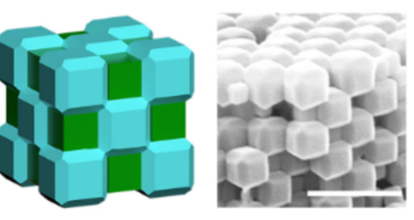Wednesday, 14 August 2024
ICN2 Scientists Succeed in Assembling Complementary MOF Particles into Three-dimensional Superstructures
These findings open the door to developing novel types of materials with complex structures that offer new characteristics and properties.

Researchers from ICN2's Supramolecular Nanochemistry and Materials Group, under the supervision of Dr Inhar Imaz and ICREA Prof. Daniel Maspoch, leader of the group, have successfully developed a method to form three-dimensional porous superstructures combining two different polyhedral particles of metal-organic frameworks (better known as MOFs). The results of their research, published in the Journal of the American Chemical Society (JACS), could be key to developing new structures and materials in the future.
What are MOFs?
MOFs are porous materials formed by the binding of metal ions to organic molecules called ligands. These components assemble in a regular way to form three-dimensional networks. They are innovative materials with great potential in various fields such as nanomedicine, energy or the chemical industry due to their diverse properties and applications.
A revolutionary assembly method
In this study, researchers have presented a new porous superstructure (similar to the chemical structure of common salt, or NaCl) using MOF particles assembled like pieces of a "chemical puzzle". Specifically, the particles were complementary in shape, size and electric charge to fit together and assemble into this new material.
These results open a wide range of new possibilities for creating complex superstructures that include particles with different properties, such as size, shape, porosity or chemical composition. This is a great opportunity to produce materials with new magnetic, photonic, electronic, mechanical or thermal properties.
Reference article:
Meng, L; Fonseca, J; Sánchez-Naya, R; Ghadiri, AM; Imar, I; Maspoch, D. (2024). Coassembly of Complementary Polyhedral Metal–Organic Framework Particles into Binary Ordered Superstructures. Journal of the American Chemical Society. https://doi.org/10.1021/jacs.4c07194.

